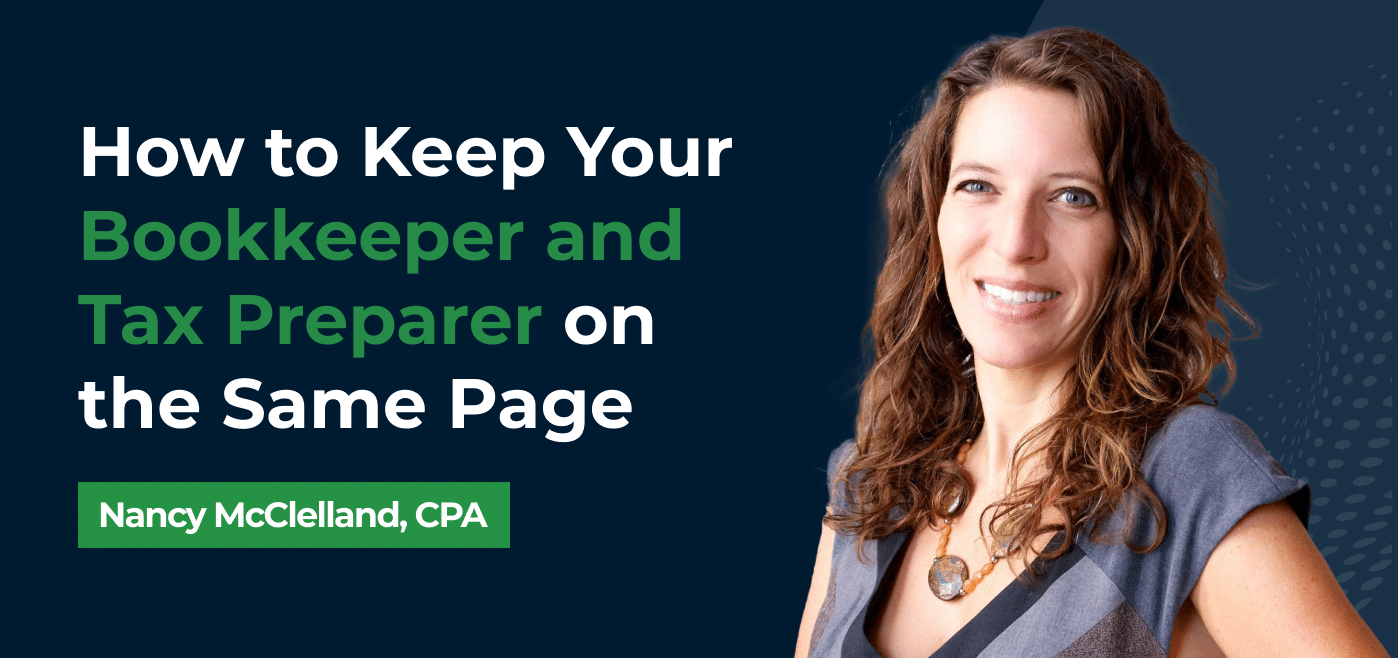Bookkeepers think tax pros will clean up their mess. Tax pros think bookkeepers don’t know what they’re doing. And clients? They’re stuck in the middle."
Nancy McClelland, CPA.The divide between bookkeepers and tax preparers isn’t just frustrating; it’s costly. Miscommunication, duplicated work, and last-minute scrambles waste time and money. Worse, they leave small business clients with disorganized books and tax headaches.
At WorkflowCon 2024, Nancy McClelland, CPA and founder of The Dancing Accountant, broke down why this disconnect exists and how to fix it.
The solution? A collaborative workflow that aligns bookkeepers and tax professionals, making tax season smoother, financials cleaner, and client service stronger.
If you’ve ever found yourself muttering “Why didn’t the bookkeeper clean this up?” or “Why does the Tax Pro keep changing my numbers?”—this article is for you.
The Problem: A System Built for Conflict
Bookkeepers and tax pros approach financials from different perspectives:
- Bookkeepers manage daily transactions, categorize expenses, and keep financial records clean.
- Tax preparers focus on compliance, tax strategy, and preparing returns that minimize liabilities.
When these roles operate in silos, misalignment happens. Bookkeepers assume tax pros will handle final adjustments, while tax pros assume bookkeepers should have done it right the first time.
“I have heard every imaginable complaint from both sides,” McClelland said.
Bookkeepers get frustrated when tax pros change things without explanation. Tax pros get frustrated when they inherit messy books. And clients? They just want things done right without being stuck in the crossfire."
Nancy McClelland, CPA.The Solution: A Workflow That Works for Everyone
A structured workflow ensures that both bookkeepers and tax preparers:
– Know their responsibilities.
– Communicate proactively.
– Work efficiently instead of duplicating efforts.
Here’s how to build a collaboration-first workflow that eliminates confusion and keeps everyone in sync.
Step 1: Set Clear Expectations Before Tax Season
The worst time to fix communication issues is during tax season when everyone is overwhelmed. The best time? Right now.
“Taxes are getting harder. The average small business tax return takes 60 percent longer to prepare than it did six years ago,” McClelland explained. “And tax season was already awful, to begin with!”
How to Set Expectations
- Schedule a Pre-Tax Season Meeting
- Bookkeepers, tax pros, and clients should meet before year-end.
- Align on how financials should be structured, what the tax pro needs, and what the bookkeeper should clean up.
- Define Who Handles What
- Who reconciles payroll benefits?
- Who classifies capital assets vs. expenses?
- Who ensures owner compensation is separated properly?
- Who verifies that donations qualify as tax-deductible?
- Create a Shared Accountability Chart
- List all tasks required for a clean tax return.
- Assign each task to bookkeeper, tax preparer, or client—no gray areas.
“An accountability chart is a game-changer,” McClelland said. “It prevents the ‘I thought you were handling that’ conversation when it’s already too late.”
Step 2: Improve Monthly and Year-End Workflows
Most tax season headaches stem from incomplete or inconsistent bookkeeping. Fixing this before year-end makes everyone’s life easier.
How to Strengthen Workflows
- Integrate Tax Prep Tasks into the Bookkeeper’s Monthly Process
- Reconcile payroll benefit accounts every month, not just at year-end.
- Request and store receipts as transactions happen instead of scrambling for them later.
- Confirm capital assets vs. expenses before they hit the tax preparer’s desk.
“If a tax pro has to clean up a bookkeeper’s work during tax season, that’s a problem,” McClelland said. “The goal is to catch issues before they become last-minute emergencies.”
- Use Standardized Work Papers
- Bookkeepers should attach reconciliation notes to every finalized financial statement.
- Tax pros should review those notes before making adjustments—no more guessing.
- Leverage a Project Management System
- Use Financial Cents or similar workflow tools to track what’s done, what’s pending, and who’s responsible.
- Ensure source documents (bank statements, payroll reports, receipts) are easily accessible to both parties.
Everyone on the team should know exactly where to find source documents. That alone saves hours of frustration"
McClellandStep 3: Communicate More, Not Just at Tax Time.
Most bookkeeper-tax pro relationships only involve one meeting: when tax season panic sets in. That’s a mistake.
I know nobody wants more meetings. But setting up regular check-ins actually saves time in the long run,"
Nancy McClelland, CPA.How to Make Communication Work
1. Hold a Pre-Tax Season Meeting (Year-End Planning)
Timing: Late November or early December
This is the most important meeting of the year. It sets expectations, prevents surprises, and ensures that tax season starts with clean books—not a mess to untangle.
What to discuss:
- Finalize year-end adjustments (capital assets, expense classifications, payroll reconciliations).
- Determine what’s needed from the client (documents, receipts, W-9s, etc.).
- Set deadlines for bookkeeper-tax pro handoff (e.g., “Books closed by Jan 15, tax prep begins Jan 20”).
- Review the previous year’s tax return and identify areas to improve recordkeeping.
The bookkeeper and tax pro should be on the same page before the new year starts. That way, there are no last-minute surprises or frantic requests in March,"
Nancy McClelland, CPA.2. Quarterly Check-Ins (Before Estimated Tax Payments Are Due)
Timing: Every quarter—around April, June, September, and December
Quarterly check-ins keep financial records up to date and improve tax planning. Rather than waiting until tax time to fix issues, the tax pro can provide proactive advice throughout the year.
What to discuss:
- Major financial changes (new hires, large purchases, unexpected revenue spikes).
- Review estimated tax payments to avoid cash flow surprises.
- Address compliance issues early (e.g., payroll tax updates, deductible expenses, tax credits).
- Standardize reporting formats so the bookkeeper and tax pro use consistent charts of accounts.
“When tax pros stay involved all year, they can actually help clients save money on taxes instead of just filing the paperwork,” McClelland noted. For bookkeepers, this meeting is a chance to confirm that financials are being recorded in a way that makes tax prep seamless. It’s also a time to ask questions, clarify tax rules, and refine monthly workflows.
3. Create a Shared FAQ Sheet to Improve Alignment
Timing: Update annually and share with all involved parties
One of the biggest sources of friction between bookkeepers and tax preparers is unspoken expectations. Bookkeepers don’t always know how a specific tax pro likes things categorized. Tax preparers don’t always understand a bookkeeper’s workflow.
A shared FAQ sheet that clarifies key expectations and preferences.
What to include:
- How should vehicle expenses be recorded? (e.g., mileage vs. direct expenses)
- Where should meals and entertainment be categorized? (Tax laws change, and default charts of accounts aren’t always accurate.)
- What format should reports be delivered in? (Excel? PDF? Custom categories?)
- How should bookkeepers flag transactions that need review?
- Which tax-saving opportunities should be tracked throughout the year?
“Most bookkeepers would love to make their tax pro’s job easier; they just don’t always know what’s needed,” McClelland said. “Spelling it out in one place reduces frustration on both sides.”
Once created, this document should be reviewed at the pre-tax season meeting and updated annually.
Step 4: Use the Right Tools to Streamline Everything
Even with a great workflow, collaboration between bookkeepers and tax preparers can fall apart without the right systems in place.
Missing documents, scattered communication, and disorganized task management create bottlenecks that waste time, especially during tax season when every second counts.
Recommended:
1. Use a Project Management System to Track Workflows
The easiest way to eliminate confusion is to manage tasks in one centralized system.
Instead of relying on email threads or verbal updates, a project management tool allows both bookkeepers and tax pros to:
✔ Track tasks and deadlines
✔ Assign responsibilities
✔ Store key documents
✔ Maintain visibility into progress
An option to consider is Financial Cents. It is built for accounting teams, automates workflows, tracks deadlines, and keeps all communication in one place.
2. Standardize File Storage and Document Access
One of the biggest pain points in tax season is missing source documents.
A tax preparer asks for a bank statement. The bookkeeper sent it two months ago but can’t find it. The client forwards an old version. The tax pro gives up and reconciles manually.
This scenario plays out every tax season, adding unnecessary frustration and wasted time.
Some best practices for document storage include:
- Storing all important records in one secure, shared location.
- Using consistent folder structures (e.g., “2024 Tax Docs” > “Bank Statements” > “January”).
- Ensuring both bookkeepers and tax pros have access permissions to the right folders.
You may be interested in:
Key Features of a Great Accounting Document Management System
3. Automate Data Collection to Reduce Manual Work
In a recent survey, Financial Cents found that workflow automation can cut time spent on manual work from an average of one to 10 hours to an average of zero to five hours. Instead of relying on endless reminders, automation can handle document requests for you.
If you’re looking for a tool that ticks all the criteria of good workflow automation software, check out Financial Cents. This solution was built for accounting, CPA, and bookkeeping firms and has tailored features to solve your challenges.
Stop manually following up with clients for receipts. Use a tool that reminds them for you so you can focus on more important work"
Nancy McClelland, CPA.4. Use Secure Communication Channels for Faster Collaboration
Most bookkeeper-tax preparer communication happens over email, which leads to:
- Lost threads
- Missed deadlines
- Unsecured data sharing
Instead of relying on email, consider a dedicated communication tool to keep discussions organized and searchable.
Better communication tools:
- Slack – Create a dedicated channel for tax/bookkeeping collaboration.
- Microsoft Teams – Good for firms already using Microsoft 365.
- Financial Cents Internal Messaging – Keeps work-related discussions within your workflow system.
“If you’re still relying on email for tax season collaboration, you’re making things harder than they need to be,” McClelland said. “Use a tool that keeps everything in one place to find what you need instantly.”
Break the Cycle and Build a Better Workflow
We don’t need more frustration. We need more collaboration,” McClelland said. “Because when bookkeepers and tax pros work together, clients get the best of both worlds.”
If you still rely on last-minute fixes and crossed fingers, you’re choosing stress over strategy. The firms that win tax season don’t work harder; they work smarter.
In order to improve collaboration and workflow processes, using the right workflow management software is important, and that’s why a solution like Financial Cents fits the bill.
With Financial Cents, you’ll get a comprehensive view of your team’s workload, and upcoming deadlines, allowing you to prioritize tasks, allocate resources efficiently, and ensure nothing falls through the cracks.






